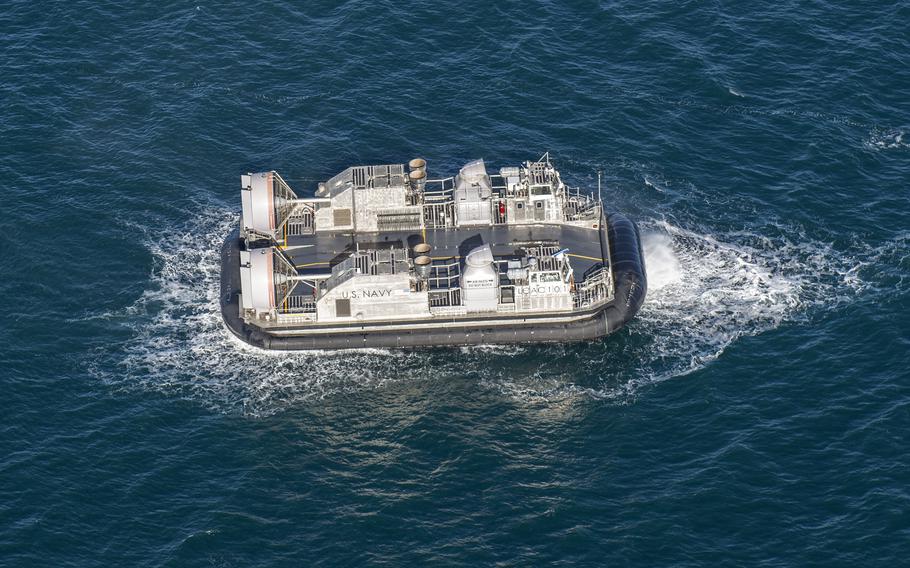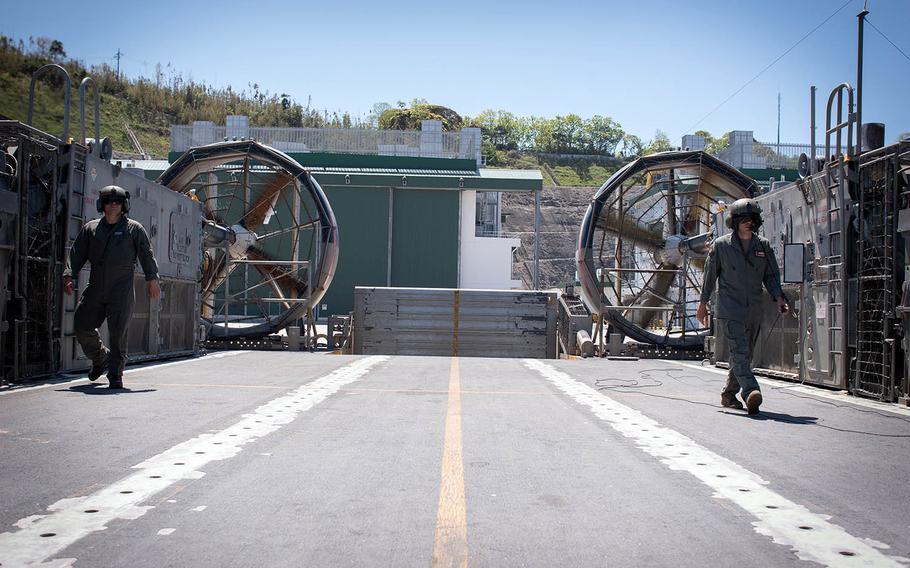
The Navy’s next generation air cushion landing craft successfully completes testing in February 2022. (Ronald Newsome/U.S. Navy)
The Navy’s new hovercraft will be ready to deploy and conduct missions in September as the service races to replace its aging landing craft fleet, according to a recent federal watchdog report.
Known as the ship-to-shore connector, the upgraded version of the service’s air-cushioned landing craft has struggled through four years of delays due to developmental testing and technical issues, most recently related to cracking propeller blades and premature gearbox wear, the Government Accountability Office said last week in its annual weapons system assessment.
However, further issues with those components are not expected and the hovercraft should complete its initial operating test and evaluation phase by the end of June, putting the craft on track to be mission ready by the fall, the GAO said.
Manufactured by Rhode Island-based Textron Inc., the new hovercraft is larger, faster and more efficient than its predecessor, which has been used since the early 1980s to ferry Marines and their equipment from amphibious ships to shore during combat or disaster-relief efforts. The older air-cushioned landing craft are reaching the end of their service life, with 68 having already been extended by a decade from 20 years to 30 years.
Program officials previously said initial operational capability — or when the new craft can deploy, conduct missions and be maintained by a unit — would be achieved when six of them were delivered to the fleet.
Nine new craft have been delivered to the Navy since the replacement program launched in 2009, including four in 2023. While it was the first time in the program’s history that four connector craft were delivered within 12 months, the GAO report stated several of the vessels took five years to complete and had “major production-quality issues.”

Sailors complete an inspection on a landing craft air cushion, or LCAC, at Sasebo Naval Base in Japan in April 2018. (James Bolinger/Stars and Stripes)
Two crafts delivered in 2023 had the lowest number of deficiencies the program has found in testing, though one had a “severe deficiency.”
“Specifically, weld repairs on the bottom of the hull failed during testing, allowing water to enter the hull, and additional weld defects were found after the acceptance trials,” the report read.
The program officials said the weld defects were corrected, and the Navy accepted the hovercraft in November 2023.
The Navy’s plan is to replace all 72 vessels of its hovercraft fleet. Of those, 24 crafts are under contract, including the nine that have been delivered.
The GAO report has noted delays in the program reaching operational status since 2020. Some hulls had issues with leaks in the propeller lubricating oil system, failure of the craft de-ice propulsor shroud, abrasions on the bow ramp cables, as well as propeller blade erosion and air leakage in the craft cushion vanes, which delayed testing and delivery. Those issues were corrected and did not impact the delivery of later hulls.
The report raised concerns about a stable production line due to a lack of funding.
Originally, the program’s timeline outlined five hovercrafts would be procured each fiscal year. While the contractor demonstrated it could provide four craft per year, the service is slowing its procurement for fiscal years 2025-28, accepting just two crafts per year, according to the Navy’s fiscal 2024 budget estimate.
The decision to slow the procurement was attributed to the current level of planned funding for fiscal 2025 through 2028, according to the GAO.
“The program sees this lower level of craft procurement as a cost risk. It reported that to maintain the contractor’s production line and increase cost savings in procuring future [landing craft], it would need to increase the number of craft procured annually, but that it cannot do so at the current level of planned funding,” the report states.
The first reported program cost estimate in 2012 was $5.3 billion, with a unit cost of $73 million per vessel. As of 2023, according to the report, the program is expected to cost $6.5 billion and $90 million per vessel.
In the Navy’s fiscal 2025 budget, the service requested a $17,000 increase to its Amphibious Tactical Support Unit program to support the sustainment of aging landing craft beyond their expected service life, citing a delay in the delivery of new craft.